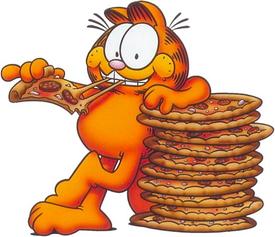Americans aren't fat because of "too much junk food" (Cornell University Infographic)
Options

ElJefeChief
Posts: 650 Member
Replies
-
the data looks like we're eating pretty much the same except 2010 adds a couple donuts per day (grains, added fats, and accounts for added sugar increase).
Still, the problem is that a 2010 average person is CHOOSING to eat more foods, and it's the CHOICE, not the food, that is ultimately the problem.
pretty fair summary IMO though.0 -
This content has been removed.
-
0
-
since can just post the pic:
 0
0 -
Thanks for this.0 -
Hmm. Someone at Cornell forgot to proofread. Most people don't snack on sweaty things.
That said, I don't think the result is all that surprising.0 -
The second infographic is a little hard to follow, besides the obvious typo of "sweat snacks", I find the conclusion a little hard to follow. I think if I understand it correctly, they are saying, for example, that underweight people drink 65% more soda than normal weight people, but that overweight people eat 18% less salty snacks than a normal weight person?
Otherwise, I think the article on the whole is good - it isn't any particular food or type of food that is causing the obesity epidemic, it is the consumption of too many calories...
In for the impending bashing of grains and fats...0 -
I'm going start by saying I hate info graphics in general, but here are the questions I have based on what is presented here (other than sweat snacks, which I now have the urge to add to the food database):
For Daily Calories Consumed by the Average American, the conclusion is that the calories aren't coming from junk food because they are high in added sugars, and the image shows more calories come from grains and fats. But we all know that junk food is made of just added sugar, it often contains a good amount of fat, which together make foods hyper-palatable. When you also take into account that many junk foods also contain grains like flour, it seems like they are just trying to exclude junk food by looking at one factor (sugar). There isn't even a section for junk food on the chart, so how do we know that those foods didn't provided calories that went into the grain/fat categories to give those results?
For the second image about fast food, soda, and candy, the article that information is based on doesn't seem to be published yet, so I have no idea what criteria they are using to determine consumption or how the data was collected, nor whether any data was collected on whether individual intake has changed over time. An obese person may consume the same or almost as much junk food as a normal weight person in the averages, however if the consumption of those foods is more than they consumed when they were a normal weight person, it would be reasonable to suggest that those foods are a factor in their weight gain. Not having the study available makes it kind of hard to critically examine the data presented.0 -
Food does not make you fat. It's eating too much of it that makes you fat.0
-
flippy1234 wrote: »Food does not make you fat. It's eating too much of it that makes you fat.
Although i agree, for the sake of protecting people from themselves, it is still prudent to inform populations about food choices that offer little in the way of nutrition and suggest healthier choices.
In the scheme of an overall diet that would be equally nutritious overall, there should be little health difference if the "throwaway" calories (calories after nutrition goals have been met) were a low nutrient fruit like apples/bananas or a donut. However, if not an equal nutrient achievement daily, junk food contributes to a lack of nutrients due to taking up calories that could be more nutritious food.
0 -
catscats222 wrote: »could not get link to work - prob b/c of an ad blocker i have
but curious - what is the article blaming obesity on besides
not eating healthy foods? sedentary lifestyle?
More calories.0 -
It seems to support that we're all different and all gain weight for different reason from different food. But I guess the ONE way we're the same is that if we eat more energy than our body uses, we'll gain weight over time (barring certain rare metabolic disorders).0
-
It seems to support that we're all different and all gain weight for different reason from different food. But I guess the ONE way we're the same is that if we eat more energy than our body uses, we'll gain weight over time (barring certain rare metabolic disorders).
And that there's not some smoking gun new food MAKING us overeat.
0 -
I'm going start by saying I hate info graphics in general, but here are the questions I have based on what is presented here (other than sweat snacks, which I now have the urge to add to the food database):
For Daily Calories Consumed by the Average American, the conclusion is that the calories aren't coming from junk food because they are high in added sugars, and the image shows more calories come from grains and fats. But we all know that junk food is made of just added sugar, it often contains a good amount of fat, which together make foods hyper-palatable. When you also take into account that many junk foods also contain grains like flour, it seems like they are just trying to exclude junk food by looking at one factor (sugar). There isn't even a section for junk food on the chart, so how do we know that those foods didn't provided calories that went into the grain/fat categories to give those results?
I had a similar thought, but on further review it appears they did a diet analysis to see how much junk food the participants were eating -- they didn't base the junk food thing on the added sugar numbers. (Obviously many "junk foods" are high in fats and not necessarily sugar.)
Here's the full study, which I have not yet read: http://papers.ssrn.com/sol3/papers.cfm?abstract_id=26682140 -
Yes, yes, I knew it was potentially a double entendre. I don't consider that 'snacking', but maybe I'm behind on the current jargon.0 -
These infographic guys...there's a reason they went to drawing school. Can't spell. Sweat snacks?0
-
So blame the twinkie and the doughnut. Cut back some on those two.0
-
I'd rather see them look at how average portion sizes have increased to ridiculousness over the years and just conclude by saying "don't eat so much."0
-
extra_medium wrote: »I'd rather see them look at how average portion sizes have increased to ridiculousness over the years and just conclude by saying "don't eat so much."
This is a big part of it as well. The food itself is not "bad". It's the mass quantity in which it is ingested. Add to that over all the activity level of most people has declined and the accessibility to fast food and convenience food has dramatically increased. Regardless, it still comes down to personal choice and responsibility but education as far a proper serving sizes needs to start at an early age.0 -
catscats222 wrote: »could not get link to work - prob b/c of an ad blocker i have
but curious - what is the article blaming obesity on besides
not eating healthy foods? sedentary lifestyle?
higher caloric intake in general....
you don't get fat because you ate a doughnut or a slice of pizza...you get fat when you consume more energy (calories) than your body requires to operate. when you consume more energy than your body requires, that excess is stored as fat...basically your backup generator. when you consume less energy than your body requires, that back up generator kicks on to make up the difference and you burn fat for energy.0 -
I have to take the slide showing "Consumption in Relation to Normal Weight Individuals" with a fairly large grain of salt, until I can confirm that its not based on self-reporting, though. The second link provided says the actual study will be published soon. Maybe we can track it down when that happens.0
-
lemurcat12 wrote: »I'm going start by saying I hate info graphics in general, but here are the questions I have based on what is presented here (other than sweat snacks, which I now have the urge to add to the food database):
For Daily Calories Consumed by the Average American, the conclusion is that the calories aren't coming from junk food because they are high in added sugars, and the image shows more calories come from grains and fats. But we all know that junk food is made of just added sugar, it often contains a good amount of fat, which together make foods hyper-palatable. When you also take into account that many junk foods also contain grains like flour, it seems like they are just trying to exclude junk food by looking at one factor (sugar). There isn't even a section for junk food on the chart, so how do we know that those foods didn't provided calories that went into the grain/fat categories to give those results?
I had a similar thought, but on further review it appears they did a diet analysis to see how much junk food the participants were eating -- they didn't base the junk food thing on the added sugar numbers. (Obviously many "junk foods" are high in fats and not necessarily sugar.)
Here's the full study, which I have not yet read: http://papers.ssrn.com/sol3/papers.cfm?abstract_id=2668214
I think that's just the abstract. Thanks for posting. Wansink is (or was) director of that Cornell lab in the infographic and has written good books about eating habits.
The abstract lists methodology that seems odd, though. They looked at only two days of food intake, for example, and excluded morbidly obese people.
Though the result doesn't shock me much. I never thought overweight people were that way due to candy or fast food so much as just overall high-calorie intake of low nutrient-density food, which comes in all kinds of packages besides 'candy', 'soda' and 'fast food'.0 -
lemurcat12 wrote: »I'm going start by saying I hate info graphics in general, but here are the questions I have based on what is presented here (other than sweat snacks, which I now have the urge to add to the food database):
For Daily Calories Consumed by the Average American, the conclusion is that the calories aren't coming from junk food because they are high in added sugars, and the image shows more calories come from grains and fats. But we all know that junk food is made of just added sugar, it often contains a good amount of fat, which together make foods hyper-palatable. When you also take into account that many junk foods also contain grains like flour, it seems like they are just trying to exclude junk food by looking at one factor (sugar). There isn't even a section for junk food on the chart, so how do we know that those foods didn't provided calories that went into the grain/fat categories to give those results?
I had a similar thought, but on further review it appears they did a diet analysis to see how much junk food the participants were eating -- they didn't base the junk food thing on the added sugar numbers. (Obviously many "junk foods" are high in fats and not necessarily sugar.)
Here's the full study, which I have not yet read: http://papers.ssrn.com/sol3/papers.cfm?abstract_id=2668214
Thanks, my earlier search turned up nothing but I was also headed out the door and didn't have time to play around with google. It looks like the data came from the NHANES 2007-2008, but then the graphic about calories from food is from 2013, which isn't terribly off but trying to support an explanation of data from 2007 with stats from 2013 is a bit backwards, unless Cornell has a time machine (in which case MIT is probably gonna cut someone).
I have many issues with the use of the NHANES in general, including self-reported data, demographics, and fun with statistical analysis to account for demographic issues. I'd be interested to see the full study to get a better sense of how they came to their conclusions.0 -
That may go for the country, but every person has to look at their own diet and make the changes necessary. So, it's interesting but not super-helpful on an individual basis.
You meant "not", right?I'm going start by saying I hate info graphics in general, but here are the questions I have based on what is presented here (other than sweat snacks, which I now have the urge to add to the food database):
For Daily Calories Consumed by the Average American, the conclusion is that the calories aren't coming from junk food because they are high in added sugars, and the image shows more calories come from grains and fats. But we all know that junk food is made of just added sugar, it often contains a good amount of fat, which together make foods hyper-palatable. When you also take into account that many junk foods also contain grains like flour, it seems like they are just trying to exclude junk food by looking at one factor (sugar). There isn't even a section for junk food on the chart, so how do we know that those foods didn't provided calories that went into the grain/fat categories to give those results?
For the second image about fast food, soda, and candy, the article that information is based on doesn't seem to be published yet, so I have no idea what criteria they are using to determine consumption or how the data was collected, nor whether any data was collected on whether individual intake has changed over time. An obese person may consume the same or almost as much junk food as a normal weight person in the averages, however if the consumption of those foods is more than they consumed when they were a normal weight person, it would be reasonable to suggest that those foods are a factor in their weight gain. Not having the study available makes it kind of hard to critically examine the data presented.
Not criticizing! Done it myself! Leave out (or add in) one word and the whole thing changes. Just trying to make a helpful point, not a "You cannot type!" point, so maybe you can edit or clarify.
0 -
-
So we're back to fat being the enemy now? Good times. But if you listen to that, they say that fast food isn't the issue, yet clearly obese people eat too many French fries (possibly because it's served with EVERYTHING in restaurants, maybe?).0
-
That may go for the country, but every person has to look at their own diet and make the changes necessary. So, it's interesting but not super-helpful on an individual basis.
You meant "not", right?I'm going start by saying I hate info graphics in general, but here are the questions I have based on what is presented here (other than sweat snacks, which I now have the urge to add to the food database):
For Daily Calories Consumed by the Average American, the conclusion is that the calories aren't coming from junk food because they are high in added sugars, and the image shows more calories come from grains and fats. But we all know that junk food is made of just added sugar, it often contains a good amount of fat, which together make foods hyper-palatable. When you also take into account that many junk foods also contain grains like flour, it seems like they are just trying to exclude junk food by looking at one factor (sugar). There isn't even a section for junk food on the chart, so how do we know that those foods didn't provided calories that went into the grain/fat categories to give those results?
For the second image about fast food, soda, and candy, the article that information is based on doesn't seem to be published yet, so I have no idea what criteria they are using to determine consumption or how the data was collected, nor whether any data was collected on whether individual intake has changed over time. An obese person may consume the same or almost as much junk food as a normal weight person in the averages, however if the consumption of those foods is more than they consumed when they were a normal weight person, it would be reasonable to suggest that those foods are a factor in their weight gain. Not having the study available makes it kind of hard to critically examine the data presented.
Not criticizing! Done it myself! Leave out (or add in) one word and the whole thing changes. Just trying to make a helpful point, not a "You cannot type!" point, so maybe you can edit or clarify.
 0
0 -
-
I think the thing that jumps out at me from the first infographic, it's not one or two specific things that are causing the obesity crisis...consumption of ALL categories increased (with vegetables remaining essentially constant).0
This discussion has been closed.
Categories
- All Categories
- 1.4M Health, Wellness and Goals
- 396.8K Introduce Yourself
- 44.2K Getting Started
- 260.9K Health and Weight Loss
- 176.3K Food and Nutrition
- 47.6K Recipes
- 232.8K Fitness and Exercise
- 450 Sleep, Mindfulness and Overall Wellness
- 6.5K Goal: Maintaining Weight
- 8.7K Goal: Gaining Weight and Body Building
- 153.3K Motivation and Support
- 8.3K Challenges
- 1.3K Debate Club
- 96.5K Chit-Chat
- 2.6K Fun and Games
- 4.5K MyFitnessPal Information
- 16 News and Announcements
- 18 MyFitnessPal Academy
- 1.4K Feature Suggestions and Ideas
- 3.1K MyFitnessPal Tech Support Questions





















